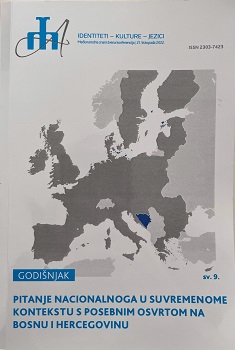Logori Armije BiH u funkciji zatiranja nacionalnoga identiteta Hrvata tijekom Domovinskoga rata u Bosni i Hercegovini (1992. – 1995.)
Camps of the BiH Army in the Function of Obliterating National Identity Croats During the Homeland War in Bosnia and Herzegovina (1992-1995)
Author(s): Miljenko Brekalo, Hrvoje Mandić, Stjepan AdanićSubject(s): Studies in violence and power, Inter-Ethnic Relations, Politics and Identity, Peace and Conflict Studies, Wars in Jugoslavia
Published by: Filozofski fakultet Sveučilišta u Mostaru
Keywords: Camps; BiH Army; Croats; HVO; Bosnia and Herzegovina;
Summary/Abstract: In the paper, the authors deal with the analysis of the functioning of the camps of the Army of Bosnia and Herzegovina, which primarily had the function of erasing the national identity of the Croats, whose existence was contrary to the provisions of international (wartime) humanitarian law, i.e. the 3rd Geneva Convention on the Treatment of Prisoners of War of August 12, 1949. In the paper, the authors will perform a complete analysis of the criminogenic actions of individual members of the BiH Army towards captured Croatian civilians and members of the Croatian Defense Council (HVO) during the fiercest armed conflicts between Bosniaks and Croats, i.e. during the Homeland War in BiH (1992-1995). Part of the command structure of the Army of Bosnia and Herzegovina had as its goal the destruction of the national identity of the Croats in Bosnia and Herzegovina, especially in the area of central Bosnia and other areas of Bosnia and Herzegovina where they did not represent an absolute majority. Namely, some Bosniak commanders behaved as if the area where the Croats had been living for centuries was terra nullius, i.e. a no-man’s land where they could ethnically cleanse, according to their own “natural right”, to make a state exclusively composed of members of the Bosniak nation. The paper used the description method, the historical-narrative method, the content analysis method, the synthesis method, the counting/enumeration method, and the oral (oral) history method. According to available data for 23 municipalities, that is, 331 camps of the Army of Bosnia and Herzegovina, 14,444 Croats were detained, of which 10,386 were civilians and 4,098 members of the HVO. 632 Croats were killed in the camps, and fifty of them were ritually killed by members of the El Mujahid unit, which was composed of radical Mujahideen, foreigners and Muslims from Bosnia and Herzegovina, and operated as part of the 3rd Corps of the Army of BiH.
Journal: Identiteti - Kulture - Jezici
- Issue Year: 9/2023
- Issue No: 1
- Page Range: 83-114
- Page Count: 32
- Language: Croatian

